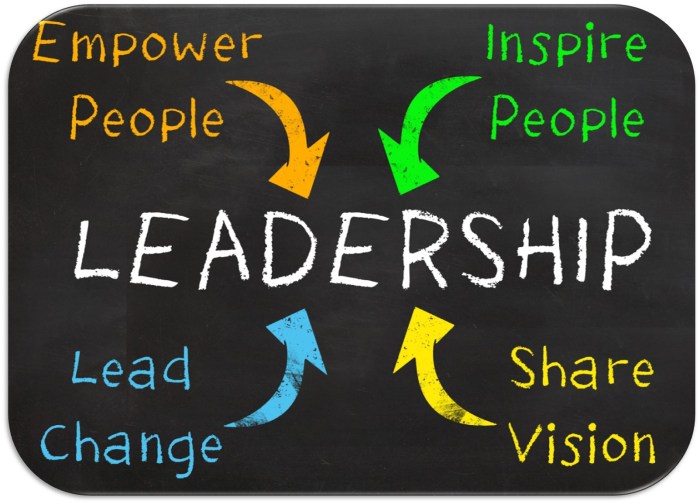Leadership Development sets the stage for this enthralling narrative, offering readers a glimpse into a story that is rich in detail with american high school hip style and brimming with originality from the outset.
Get ready to dive into the world of developing exceptional leaders, where skills, strategies, and challenges collide to shape the future of leadership.
Introduction to Leadership Development
Leadership development is the process of improving the skills, abilities, and qualities of individuals who hold leadership positions within an organization. It is essential for organizations to invest in leadership development to ensure that their leaders have the necessary competencies to drive success and growth.
In the context of development, leadership differs from management in that leadership focuses on inspiring and influencing others to achieve a common goal, while management is more about overseeing tasks and ensuring efficiency. Effective leadership development programs help individuals cultivate their leadership skills, emotional intelligence, and strategic thinking.
Examples of Successful Leadership Development Programs
- The Leadership Development Program at Google focuses on identifying and nurturing high-potential employees to prepare them for leadership roles within the company.
- The Center for Creative Leadership offers a range of leadership development programs that focus on building self-awareness, communication skills, and collaboration among leaders.
- General Electric’s Leadership Development Program is known for its rotational structure, where participants gain exposure to various functions and business units to develop a well-rounded understanding of the organization.
Key Components of Leadership Development
Leadership development involves cultivating essential skills and qualities that are crucial for effective leadership. Here we will explore key components of leadership development, including the importance of emotional intelligence and strategies for fostering leadership skills in individuals.
Essential Skills and Qualities of a Great Leader
- Effective communication: Great leaders are able to clearly articulate their vision and goals to inspire and motivate others.
- Decision-making: A strong leader is able to make tough decisions in a timely manner, considering all relevant factors.
- Empathy: Understanding and empathizing with others’ perspectives is essential for building strong relationships and trust.
- Adaptability: Leaders must be able to navigate through change and uncertainty, adjusting their strategies as needed.
The Importance of Emotional Intelligence
Emotional intelligence plays a crucial role in leadership development as it enables leaders to understand and manage their own emotions, as well as those of others. Leaders with high emotional intelligence are better equipped to handle conflicts, build strong teams, and foster a positive work environment.
Strategies for Fostering Leadership Skills
- Mentorship programs: Pairing aspiring leaders with experienced mentors can provide valuable guidance and support.
- Leadership training workshops: Offering workshops on communication, decision-making, and other leadership skills can help individuals develop and enhance their abilities.
- Feedback and reflection: Encouraging individuals to seek feedback, reflect on their actions, and continuously improve is essential for leadership growth.
Methods for Leadership Development

When it comes to developing leadership skills, there are various approaches that organizations can take. These methods aim to enhance the abilities of individuals to lead effectively in different situations.
Mentoring
- Mentoring involves a more experienced individual providing guidance, advice, and support to a less experienced person.
- It allows for personalized development, feedback, and the sharing of knowledge and experience.
- Through a mentoring relationship, future leaders can gain valuable insights and learn from the successes and challenges of their mentors.
Coaching, Leadership Development
- Coaching focuses on improving specific skills, behaviors, and performance of individuals.
- It often involves setting goals, providing feedback, and creating action plans to help individuals reach their full potential.
- Coaches can help leaders identify their strengths, weaknesses, and areas for growth, leading to continuous improvement.
Training
- Training programs are designed to provide leaders with the necessary knowledge, skills, and tools to excel in their roles.
- They can include workshops, seminars, online courses, and other learning opportunities to enhance leadership competencies.
- Training helps leaders stay updated on industry trends, best practices, and innovative strategies to lead effectively.
Formal vs. Informal Methods
Formal leadership development programs are structured initiatives organized by companies to train and develop leaders systematically. On the other hand, informal methods like on-the-job learning involve experiential learning, shadowing, and hands-on experiences that occur naturally in the workplace.
Case Studies of Companies
Several companies have excelled in implementing effective leadership development initiatives. One such example is General Electric (GE), which is known for its leadership development programs that focus on identifying and nurturing future leaders through mentoring, coaching, and training opportunities. Another company, Google, emphasizes a culture of continuous learning and development, offering various leadership programs and resources to empower its employees to lead with impact.
Challenges in Leadership Development

Implementing successful leadership development programs can be challenging due to various obstacles that organizations may face. These challenges can hinder the growth and effectiveness of leadership within a company. It is essential to identify these obstacles and develop strategies to overcome them for continuous leadership growth.
Lack of Diversity and Inclusion
One common challenge in leadership development is the lack of diversity and inclusion within leadership programs. When there is a lack of representation from different backgrounds, perspectives, and experiences, it can limit the overall effectiveness of leadership development efforts. This can lead to a narrow-minded approach to problem-solving and decision-making, hindering innovation and growth within the organization.
To overcome this challenge, organizations need to prioritize diversity and inclusion in their leadership development initiatives. By actively seeking out diverse candidates for leadership roles, providing training on unconscious bias, and creating a culture that values different perspectives, organizations can foster a more inclusive and innovative leadership environment.
Overcoming Challenges and Fostering Growth
- Provide mentorship and coaching programs to support leadership development.
- Encourage continuous learning and skill development among leaders.
- Implement feedback mechanisms to evaluate the effectiveness of leadership development programs.
- Create a culture that values collaboration, teamwork, and open communication.
- Offer opportunities for leaders to take on new challenges and responsibilities to foster growth.


